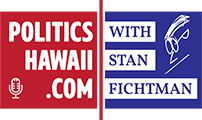I write this post just coming off the plane from Kona, Hawaii. I spent three days on the Big Island with my wife and my daughter touring around the island. While it was a visit to see sites (it was my daughters first time on the island), the big news of what was going on at Mauna Kea and the standoff between the Ki’I (“protectors”) and the State of Hawaii over the building of the Thirty Meter Telescope.
And yes, we did drive on Daniel K. Inouye Highway (Saddle Road) and passed by the demonstration happening at the intersection of DKI Highway and Mauna Kea Access Road. I didn’t stop to visit the encampment as we were pressed for time. But I will say if we did have more time, I might have been more curious as a political scientist to stop and visit. For this first post, some observations of what I saw driving by the “intersection”

You get your first sense that something is up when you see a Hawaii County police car about a mile down the road just monitoring traffic.
You have to ask yourself “what’s that cop car there for, out in the middle of nowhere?”
Soon enough you come upon the tent city. It is not as spread out as it seems in photos in the media, but actually compressed together, making in essence a tent city. They are behind water filled barriers to block off pedestrians and tents from the highway, keeping the highway open.
One thing that came to mind – topically really – was scenes I saw of Woodstock back in 1969.
A noted visual I saw before the intersection was that of what I assumed to be a parent playing with their child. She was swinging the kid around in a fun sort of way, both laughing. Most likely it was to pass the time up there, especially for kids whom I could see, getting board in doing nothing. Again, tents going back two or three layers from the intersection on the mountain side, at least one layer of tents across the street.
As you get closer to the intersection itself you see the stoplight installed to regulate pedestrian traffic. There are so many people by that point that you could see a need to regulate traffic. So, you slow down and more times than not, you hit a red light.
My gaze turned to the mountain and the roadway. It was blocked. A way up the road you could seek the kupuna tent that marks the actual “blockade” of the road by the Ki’i. It seemed as if it was well established and definitely not subject to quick removal, if that is what it comes down to be. People were milling about all over, with at least a hoodie on because at that level, it was just below 70 degrees Fahrenheit.
You stay at the stop light for just a moment. When the light turned green and you move on, just more tents, a lot more tents along the road on both sides. You start to get the feeling that while the debate rages about the merits of the issues of “the Mauna”, a certainty one gets is that there are a lot more people there than one initially realizes.
A last scene one has before you leave the “intersection area” is that of cars parked along the opposite side of the road. A lot of those cars, looked like rental cars like mine. That meant to me there were a lot of visitors, and a lot of money for travel and rental cars were being spent. This would be affirmed a couple of days later, at the airport, where I saw a number of Ki’i getting on flights back to Honolulu.
I could not tell how many were encamped at the area, but it would not surprise me if the actual count reached into the thousands.
My next post will talk about what I saw in the communities throughout the Big Island and how the protests on the mountain has left a light but notable fingerprint on that islands community.
